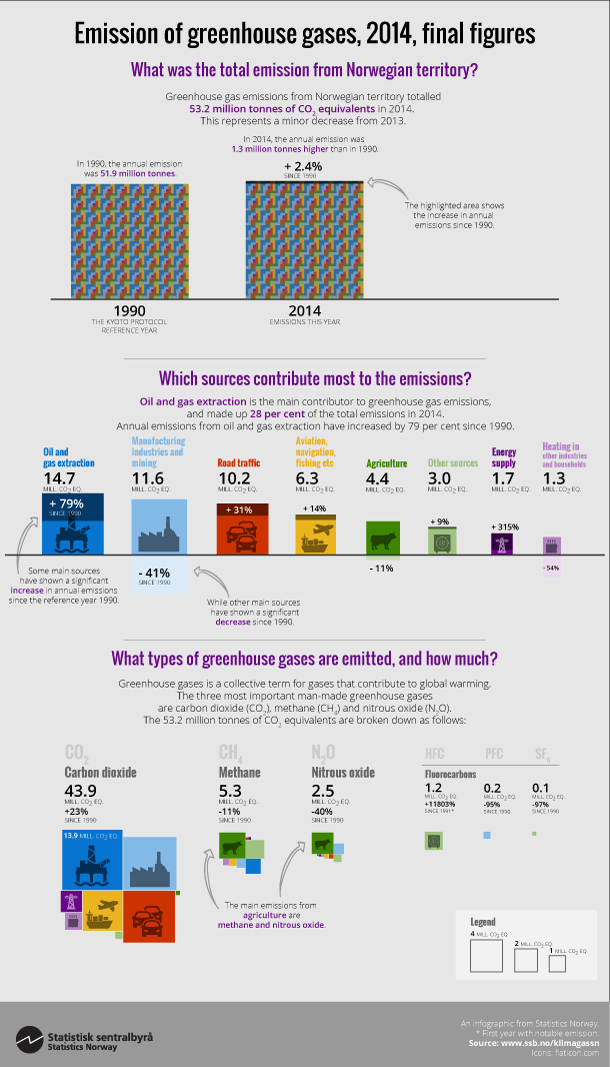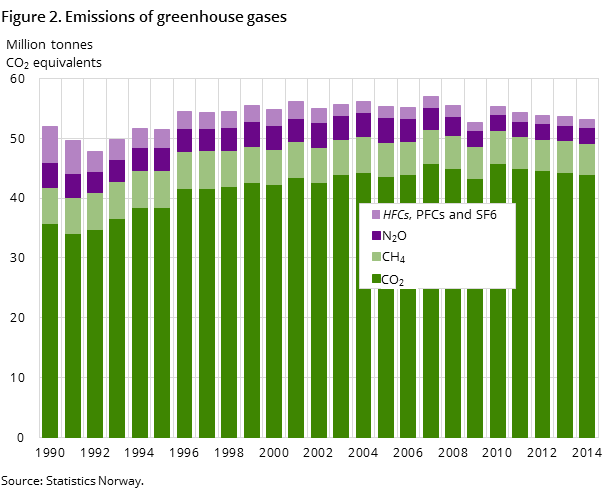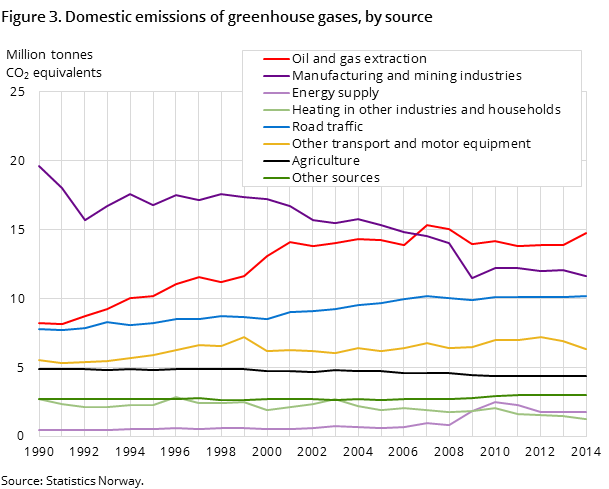Content
Published:
This is an archived release.
Minor decrease in greenhouse gas emissions in 2014
In 2014, total greenhouse gas emissions from Norwegian territory amounted to 53.2 million tonnes of CO2 equivalents. This is 0.8 per cent or 0.4 million tonnes of CO2 equivalents less than in 2013, but 2.4 per cent more than in 1990.
| 2014 | Change in per cent | ||
|---|---|---|---|
| Since 1990 | 2013 - 2014 | ||
| 1Figure for the previous year. The change in per cent shows increase in net uptake in forests since 1990. Source: NIBIO | |||
| Emissions from Norwegian territory | 53.2 | 2.4 | -0.8 |
| Oil and gas extraction | 14.7 | 78.8 | 6.1 |
| Manufacturing industries and mining | 11.6 | -40.7 | -3.6 |
| Energy supply | 1.7 | 315.1 | -2.2 |
| Heating in other industries and households | 1.3 | -53.6 | -14.7 |
| Road traffic | 10.2 | 31.1 | 0.8 |
| Aviation, navigation, fishing, motor equip. etc. | 6.3 | 14.1 | -8.6 |
| Agriculture | 4.4 | -11.2 | -1.1 |
| Other | 3.0 | 8.7 | -0.5 |
| Sinks and emissions from forest and land areas in Norway1 | -26,1 | 147,7 | 2,7 |
These are the most recent figures on Norwegian greenhouse gas emissions 1990-2014. Compared with the preliminary figures that were published in May 2015, the total emissions for 2014 were adjusted downward by 0.6 million tonnes of CO2 equivalents. Figures for previous years have also been adjusted in this publication. The revision is due to improvements in methods and data. The changes in the calculation of emissions from oil and gas extraction offshore and agriculture are the most significant, and have resulted in higher figures for offshore activities and lower figures for agriculture compared with previous calculations.
Reduced emissions from manufacturing, sea transport and heating in 2014
Lower emissions from coastal traffic and fishing, manufacturing industries, motorised equipment and heating made the largest contributions to the decrease in total emissions from 2013 to 2014. Emissions from coastal traffic and fishing were 0.37 million tonnes of CO2 equivalents lower in 2014 than in 2013 due to a reduction in the sale of fuels for coastal traffic in 2014.
Emissions from manufacturing industries were reduced mainly because of lower emissions from oil refining, which emitted 0.35 million tonnes of CO2 equivalents less in 2014 than in 2013. Heating emissions were reduced by 0.22 million tonnes of CO2 equivalents, or almost 15 per cent in 2014. Since 1990, the emissions have been more than halved due to lower consumption of heating oils.
In 2014, there was also a substantial reduction in emissions from use of motorised equipment and machines (0.24 million tonnes of CO2 equivalents).
Stable share of CO2 in greenhouse gas emissions since 2010
CO2 was responsible for 82.5 per cent of the total greenhouse gas emissions in 2014, compared to 68.8 per cent in 1990. This significant rise is mainly due to increased use of natural gas in oil and gas extraction and lower emissions of fluorinated gases and nitrous oxide in manufacturing industries. Since 2010, the CO2 share has been stable. The total greenhouse gas emissions have been reduced every year from 2010, by approximately 4 per cent overall.
Reduced share of methane and nitrous oxide
Emissions of methane (CH4) have been reduced by 11.4 per cent during the period 1990-2014. Methane made up 10 per cent of the total greenhouse gas emissions in 2014, which is 1.6 percentage points less than in 1990. The emission decrease is due to lower emissions from waste disposal sites and the reduced number of dairy cattle.
Emissions of nitrous oxide (N2O) have been reduced by slightly less than 40 per cent from 1990. The reduction is particularly caused by lower emissions from the production of fertiliser. In 2014, nitrous oxide made up 4.8 per cent of the greenhouse gas emissions.
Reduced share of fluorinated gases – but large increase for HFCs
Emissions of fluorinated gases (PFCs, HFCs, SF6) have been reduced by 76.2 per cent since 1990, and made up 2.7 per cent of the total greenhouse gas emissions in 2014. In spite of the large decrease in total emissions of fluorinated gases, there has been a significant rise in the use of HFCs in products, such as air conditioners in cars. These emissions accounted for 2.2 per cent of the greenhouse gas emissions in 2014, compared to almost zero in 1990.
Oil and gas extraction still the largest emission source
Since 2007, oil and gas extraction has been the major source of greenhouse gas emissions, and contributed to 27.7 per cent of the emissions from Norwegian territory in 2014. The emissions rose by 6.1 per cent from 2013 to 2014, particularly due to increased use of natural gas in turbines on the continental shelf.
Manufacturing industries and mining accounted for 22 per cent of the emissions, despite an emission decrease in 2014.
Road traffic was responsible for 19.2 per cent of the greenhouse gas emissions in 2014; an increase of 0.8 per cent from 2013. These emissions have risen by 31 per cent from 1990.
In 2014, 8.2 per cent of the greenhouse gas emissions originated from agriculture, which was a reduction of 1.1 per cent from 2013. Since 1990, emissions from agriculture have been reduced by 11.2 per cent.
Emissions covered by the emission trading scheme
Emissions of greenhouse gases from companies liable under the emission trading scheme totalled 24.9 million tonnes of CO2 equivalents in 2014. Emissions covered by quotas made up 46.8 per cent of the total emissions of greenhouse gases from Norwegian territory. Emission quotas for 17.1 million tonnes of CO2 equivalents were allocated for free in 2014, corresponding to 69 per cent of the total quota emissions.
Contact
-
Trude Melby Bothner
E-mail: trude.melby.bothner@ssb.no
tel.: (+47) 40 81 14 25
-
Berit Storbråten
E-mail: berit.storbraten@ssb.no
tel.: (+47) 40 81 14 23



